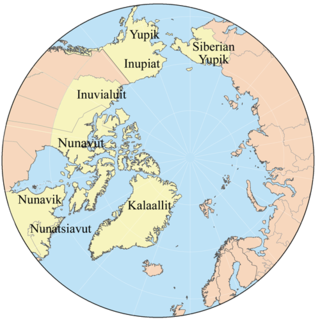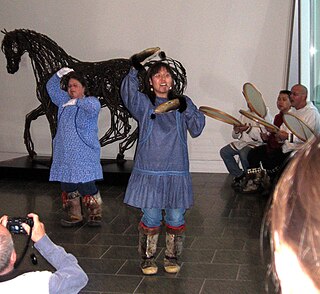Related Research Articles

The Yupik are a group of indigenous or aboriginal peoples of western, southwestern, and southcentral Alaska and the Russian Far East. They are related to the Inuit and Iñupiat. Yupik peoples include the following:

Inuit religion is the shared spiritual beliefs and practices of the Inuit, an indigenous people from Alaska, Canada, parts of Siberia and Greenland. Their religion shares many similarities with some Alaska Native religions. Traditional Inuit religious practices include animism and shamanism, in which spiritual healers mediate with spirits. Today many Inuit follow Christianity, but traditional Inuit spirituality continues as part of a living, oral tradition and part of contemporary Inuit society. Inuit who balance indigenous and Christian theology practice religious syncretism.
Nightmute is a city and village in Bethel Census Area, Alaska, United States. The population was 208 at the 2000 census and 280 as of the 2010 census.

Prehistoric Alaska begins with Paleolithic people moving into northwestern North America sometime between 40,000 and 15,000 years ago across the Bering Land Bridge in western Alaska; a date less than 20,000 years ago is most likely. They found their passage blocked by a huge sheet of ice until a temporary recession in the Wisconsin glaciation opened up an ice-free corridor through northwestern Canada, possibly allowing bands to fan out throughout the rest of the continent. Eventually, Alaska became populated by the Inuit and a variety of Native American groups. Trade with both Asia and southern tribes was active even before the advent of Europeans.
Ann Fienup-Riordan is an American cultural anthropologist known for her work with the Yup'ik of western Alaska, particularly on Nelson Island and the Yukon–Kuskokwim Delta. She lives in Anchorage, Alaska.

Masks among Eskimo peoples served a variety of functions. Masks were made out of driftwood, animal skins, bones and feathers. They were often painted using bright colors. There are archeological miniature maskettes made of walrus ivory, dating from early Paleo-Eskimo and from early Dorset culture period.

Inu-Yupiaq is a dance group at the University of Alaska, Fairbanks that performs a fusion of Iñupiaq and Yup’ik Eskimo motion dance.

The Yup'ik or Yupiaq and Yupiit or Yupiat (pl), also Central Alaskan Yup'ik, Central Yup'ik, Alaskan Yup'ik, are an Indigenous people of western and southwestern Alaska ranging from southern Norton Sound southwards along the coast of the Bering Sea on the Yukon-Kuskokwim Delta and along the northern coast of Bristol Bay as far east as Nushagak Bay and the northern Alaska Peninsula at Naknek River and Egegik Bay. They are also known as Cup'ik by the Chevak Cup'ik dialect-speaking people of Chevak and Cup'ig for the Nunivak Cup'ig dialect-speaking people of Nunivak Island.
The Messenger Feast or Kivgiq, Kevgiq, is a celebratory mid-winter festival in Alaska traditionally held by Iñupiaq and Yup'ik peoples after a strong whale harvest.

Eskimology or Inuitology is a complex of humanities and sciences studying the languages, history, literature, folklore, culture, and ethnology of the speakers of Eskimo–Aleut languages and Inuit, Yupik and Unangam peoples in historical and comparative context. This includes ethnic groups from the Chukchi Peninsula on the far eastern tip of Siberia in the Russian Federation, through Alaska of the United States, Canada’s Arctic coast and archipelago through northern embayments and Atlantic coast, to Greenland of Denmark. Originally, an Eskimologist or Inuitologist was primarily a linguist or philologist who researches Eskimo languages.

Yup'ik masks are expressive shamanic ritual masks made by the Yup'ik people of southwestern Alaska. Also known as Cup'ik masks for the Chevak Cup'ik dialect speaking people of Chevak and Cup'ig masks for the Nunivak Cup'ig dialect speaking people of Nunivak Island. They are typically made of wood, and painted with few colors. The Yup'ik masks were carved by men or women, but mainly were carved by the men. The shamans (angalkuq) were the ones that told the carvers how to make the masks. Yup'ik masks could be small three-inch finger masks or maskettes, but also ten-kilo masks hung from the ceiling or carried by several people. These masks are used to bring the person wearing it luck and good fortune in hunts. Over the long winter darkness dances and storytelling took place in the qasgiq using these masks. They most often create masks for ceremonies but the masks are traditionally destroyed after being used. After Christian contact in the late nineteenth century, masked dancing was suppressed, and today it is not practiced as it was before in the Yup'ik villages.

Yup'ik dance or Yuraq, also Yuraqing is a traditional Inuit style dancing form usually performed to songs in Yup'ik, with dances choreographed for specific songs which the Yup'ik people of southwestern Alaska. Also known as Cup'ik dance for the Chevak Cup'ik dialect speaking Inuit of Chevak and Cup'ig dance for the Nunivak Cup'ig dialect speaking Inuit of Nunivak Island. Yup'ik dancing is set up in a very specific and cultural format. Typically, the men are in the front, kneeling and the women stand in the back. The drummers are in the very back of the dance group. Dance is the heart of Yup’ik spiritual and social life. Traditional dancing in the qasgiq is a communal activity in Yup’ik tradition. The mask (kegginaquq) was a central element in Yup'ik ceremonial dancing.

Yup'ik doll is a traditional Eskimo style doll and figurine form made in the southwestern Alaska by Yup'ik people. Also known as Cup'ik doll for the Chevak Cup'ik dialect speaking Eskimos of Chevak and Cup'ig doll for the Nunivak Cup'ig dialect speaking Eskimos of Nunivak Island. Typically, Yup'ik dolls are dressed in traditional Eskimo style Yup'ik clothing, intended to protect the wearer from cold weather, and are often made from traditional materials obtained through food gathering. Play dolls from the Yup'ik area were made of wood, bone, or walrus ivory and measured from one to twelve inches in height or more. Male and female dolls were often distinguished anatomically and can be told apart by the addition of ivory labrets for males and chin tattooing for females. The information about play dolls within Alaska Native cultures is sporadic. As is so often the case in early museum collections, it is difficult to distinguish dolls made for play from those made for ritual. There were always five dolls making up a family: a father, a mother, a son, a daughter, and a baby. Some human figurines were used by shamans.
The Yupiit Piciryarait Cultural Center (YPCC), also known as Yupiit Piciryarait Cultural Center and Museum, formerly known as the Yup'ik Museum, Library, and Multipurpose Cultural Center, is a non-profit cultural center of the Yup'ik culture centrally located in Bethel, Alaska near the University of Alaska Fairbanks' Kuskokwim Campus and city offices. The center is a unique facility that combines a museum, a library, and multi-purpose cultural activity center including performing arts space, for cultural gatherings, feasts, celebrations, meetings and classes. and that celebrates the Yup'ik culture and serves as a regional cultural center for Southwest Alaska. The name of Yupiit Piciryarait means "Yup'iks' customs" in Yup'ik language and derived from piciryaraq meaning "manner; custom; habit; tradition; way of life" Construction of this cultural facility was completed in 1995, funded through a State appropriation of federal funds. Total cost for construction was $6.15 million. The center was jointly sponsored by the Association of Village Council Presidents (AVCP) and the University of Alaska Fairbanks (UAF) and at the present the center operated by the UAF's Kuskokwim Campus, AVCP and City of Bethel. The building houses three community resources: the Consortium Library, the Yup'ik Museum, and the Multi-purpose room or auditorium. The mission of the center is promote, preserve and develop the traditions of the Yup'ik through traditional and non-traditional art forms of the Alaska Native art, including arts and crafts, performance arts, education, and Yup'ik language. The center also supports local artists and entrepreneurs.

Yup'ik clothing refers to the traditional Eskimo-style clothing worn by the Yupik people of southwestern Alaska.
Paul Joseph John was an American Yup'ik elder, cultural advocate, and commercial fisherman. John was a proponent of traditional Central Alaskan Yup'ik culture, including the use of the Central Alaskan Yup'ik language and a subsistence lifestyle, including wild food. Additionally, John helped to settle the village of Toksook Bay, Alaska. A traditional chief of the Nunakauyarmiut tribe, he was a member of the Association of Village Council Presidents (AVCP), which is based in Bethel, Alaska.
Marie (Nick) Arnaq Meade is a Yup'ik professor in the humanities and also a Yup'ik tradition bearer. Meade's Yup'ik name is Arnaq which means "woman." She also works and travels with the International Council of Thirteen Indigenous Grandmothers. Meade is also part of the Nunamta Yup'ik Dance Group. Meade has been documenting the cultural knowledge of Yup'ik elders, including the values, language and beliefs of the Yup'ik people for over twenty years. She is currently an instructor at the University of Alaska Anchorage.

Yup'ik cuisine refers to the Eskimo style traditional subsistence food and cuisine of the Yup'ik people from the western and southwestern Alaska. Also known as Cup'ik cuisine for the Chevak Cup'ik dialect speaking Eskimos of Chevak and Cup'ig cuisine for the Nunivak Cup'ig dialect speaking Eskimos of Nunivak Island. This cuisine is traditionally based on meat from fish, birds, sea and land mammals, and normally contains high levels of protein. Subsistence foods are generally considered by many to be nutritionally superior superfoods. Yup’ik diet is different from Alaskan Inupiat, Canadian Inuit, and Greenlandic diets. Fish as food are primary food for Yup'ik Eskimos. Both food and fish called neqa in Yup'ik. Food preparation techniques are fermentation and cooking, also uncooked raw. Cooking methods are baking, roasting, barbecuing, frying, smoking, boiling, and steaming. Food preservation methods are mostly drying and less often frozen. Dried fish is usually eaten with seal oil. The ulu or fan-shaped knife used for cutting up fish, meat, food, and such.
The Amikuk is a creature of Yup'ik legend, said to live within the ground.
References
- ↑ Fienup-Riordan, Ann (1990). Eskimo Essays: Yup'ik Lives and How We See Them. New Brunswick, NJ: Rutgers University Press.
- 1 2 3 4 5 Fienup-Riordan, Ann (1995). Boundaries and Passages: Rule and Ritual in Yup'ik Eskimo Oral Tradition. University of Oklahoma Press. p. 267. ISBN 978-0-8061-2646-3.
- 1 2 Lorraine D. Koranda (1968). Three songs for the Bladder Festival, Hooper Bay Archived 2014-10-28 at the Wayback Machine
- 1 2 3 Stern, Pamela R. (2013). Historical Dictionary of the Inuit. Scarecrow Press. p. 41. ISBN 978-0-8108-7912-6.
- ↑ "The Bladder Festival by Grace Arai" (PDF). Archived from the original (PDF) on 2014-10-28. Retrieved 2014-10-28.
- ↑ Emily Johnson (1998), “Yup'ik Dance: Old and New,” The Journal for the Anthropological Study of Human Movement, Vol. 9, No. 3.
- ↑ Steven Jacobson (2012). Yup'ik Eskimo Dictionary, 2nd edition Archived 2017-08-03 at the Wayback Machine . Alaska Native Language Center.
- ↑ "Bladder Dance by Zaz Hollander". Archived from the original on 2015-12-04. Retrieved 2014-10-28.